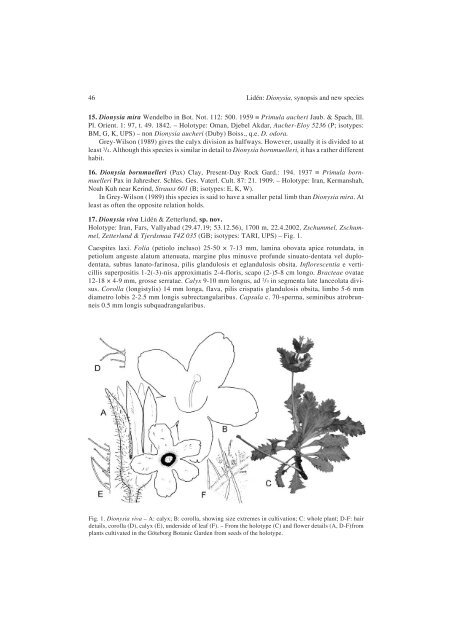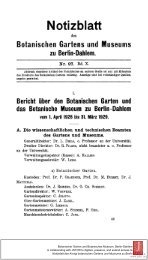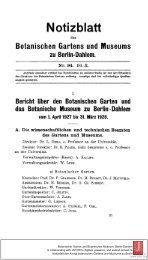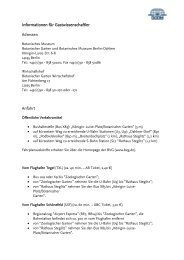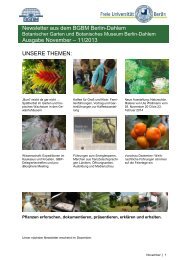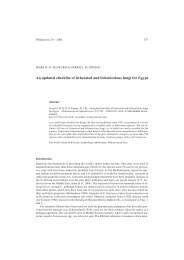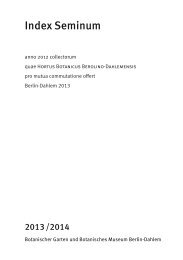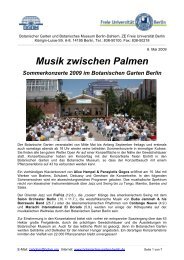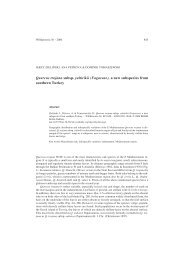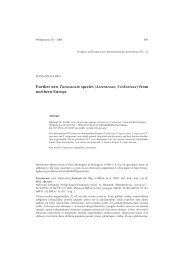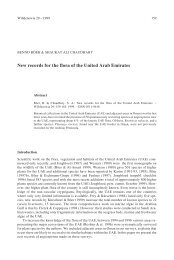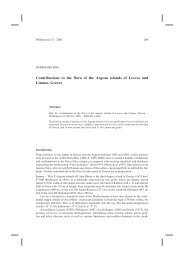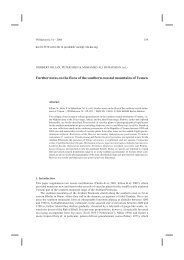The genus Dionysia (Primulaceae), a synopsis and five new species
The genus Dionysia (Primulaceae), a synopsis and five new species
The genus Dionysia (Primulaceae), a synopsis and five new species
Create successful ePaper yourself
Turn your PDF publications into a flip-book with our unique Google optimized e-Paper software.
46 Lidén: <strong>Dionysia</strong>, <strong>synopsis</strong> <strong>and</strong> <strong>new</strong> <strong>species</strong><br />
15. <strong>Dionysia</strong> mira Wendelbo in Bot. Not. 112: 500. 1959 ≡ Primula aucheri Jaub. & Spach, Ill.<br />
Pl. Orient. 1: 97, t. 49. 1842. – Holotype: Oman, Djebel Akdar, Aucher-Eloy 5236 (P; isotypes:<br />
BM,G,K,UPS)–non<strong>Dionysia</strong> aucheri (Duby) Boiss., q.e. D. odora.<br />
Grey-Wilson (1989) gives the calyx division as halfways. However, usually it is divided to at<br />
least 3 /4. Although this <strong>species</strong> is similar in detail to <strong>Dionysia</strong> bornmuelleri, it has a rather different<br />
habit.<br />
16. <strong>Dionysia</strong> bornmuelleri (Pax) Clay, Present-Day Rock Gard.: 194. 1937 ≡ Primula bornmuelleri<br />
Pax in Jahresber. Schles. Ges. Vaterl. Cult. 87: 21. 1909. – Holotype: Iran, Kermanshah,<br />
Noah Kuh near Kerind, Strauss 601 (B; isotypes: E, K, W).<br />
In Grey-Wilson (1989) this <strong>species</strong> is said to have a smaller petal limb than <strong>Dionysia</strong> mira.At<br />
least as often the opposite relation holds.<br />
17. <strong>Dionysia</strong> viva Lidén & Zetterlund, sp. nov.<br />
Holotype: Iran, Fars, Vallyabad (29.47.19; 53.12.56), 1700 m, 22.4.2002, Zschummel, Zschummel,<br />
Zetterlund & Tjerdsmaa T4Z 035 (GB; isotypes: TARI, UPS) – Fig. 1.<br />
Caespites laxi. Folia (petiolo incluso) 25-50 × 7-13 mm, lamina obovata apice rotundata, in<br />
petiolum anguste alatum attenuata, margine plus minusve profunde sinuato-dentata vel duplodentata,<br />
subtus lanato-farinosa, pilis gl<strong>and</strong>ulosis et egl<strong>and</strong>ulosis obsita. Inflorescentia everticillis<br />
superpositis 1-2(-3)-nis approximatis 2-4-floris, scapo (2-)5-8 cm longo. Bracteae ovatae<br />
12-18 × 4-9 mm, grosse serratae. Calyx 9-10 mm longus, ad 2 /3 in segmenta late lanceolata divisus.<br />
Corolla (longistylis) 14 mm longa, flava, pilis crispatis gl<strong>and</strong>ulosis obsita, limbo 5-6 mm<br />
diametro lobis 2-2.5 mm longis subrectangularibus. Capsula c. 70-sperma, seminibus atrobrunneis<br />
0.5 mm longis subquadrangularibus.<br />
Fig. 1. <strong>Dionysia</strong> viva – A: calyx; B: corolla, showing size extremes in cultivation; C: whole plant; D-F: hair<br />
details, corolla (D), calyx (E), underside of leaf (F). – From the holotype (C) <strong>and</strong> flower details (A, D-F)from<br />
plants cultivated in the Göteborg Botanic Garden from seeds of the holotype.


